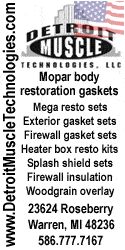Memike had a Carter BBS carb in mind, not your Holley 1920, when he wrote about the plunger.
Make sure the manifold heat control valve is free and working correctly, not stuck or hacked by someone who didn't understand why it's there and why it should be kept in working condition.
Do the
Fuel line mod. Put in a new float (the float on the 1920 is made of nitrophyll foam and will absorb gas and grow heavy, so even if it's set at the correct height you'll have a borderline flood condition). Use a quality carb kit with a
good inlet needle/seat such as the one from
www.daytonaparts.com -- good luck setting the float with the completely inadequate dumb little strip-of-paper-ruler "float gauge" all the kits come with these days. :roll: Carburetor operation and repair manuals and links to training movies and carb repair/modification threads are posted
here for free download.
Make sure you're using the correct 3/8" thick carb base (to intake) gasket, not the 1/8" thin one. If you've been running with the thin one, and you install the thick one, you'll need to readjust your kickdown linkage (if the car has an automatic transmission), making it longer to account for the carb having been lifted.
If that doesn't do the job, make a heat shield for the carb like the factory '80s item, see
here.
Be advised that you
will smell gasoline from any pre-'71 car (pre-'70 in California) because of the open carb bowl and fuel tank vents that just dump directly to atmosphere. The post '71/'70 cars have closed vent systems that dramatically reduce the amount of fuel vapor released to the air, and one of the benefits of that is much, much less fuel stink.
















